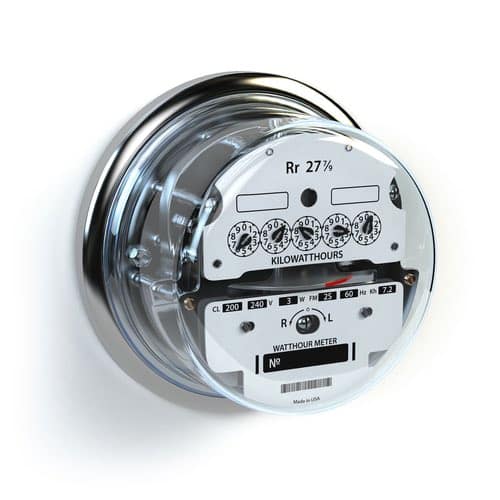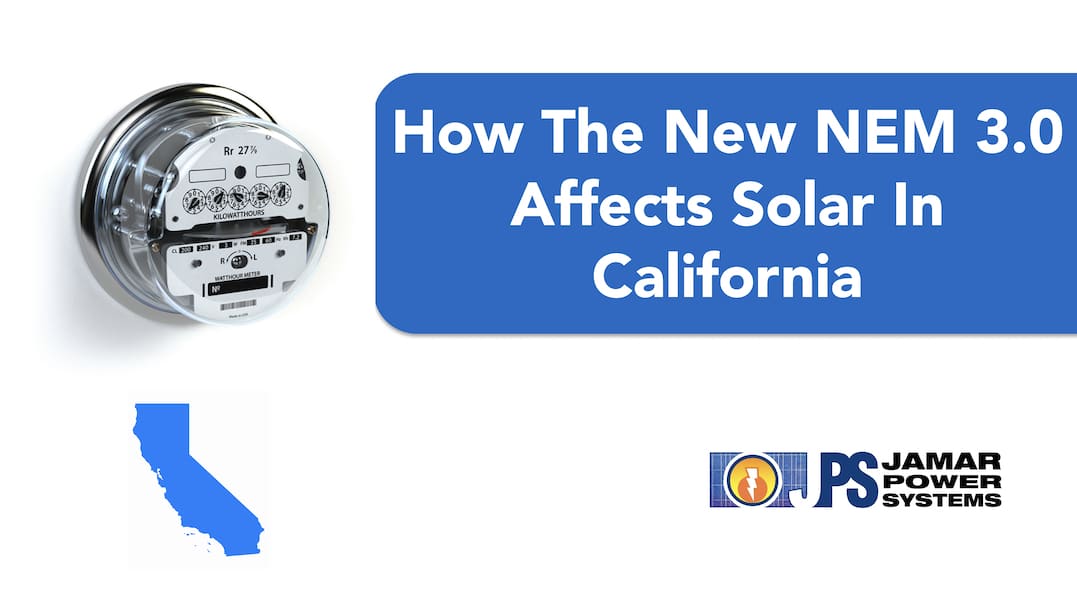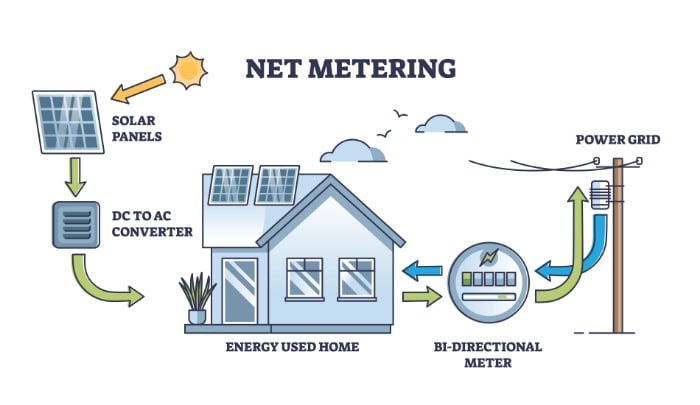NEM 3.0 & California Solar
California recently introduced major changes to its net metering program for solar energy.
Under the new NEM 3.0, homeowners will receive significantly lower export rates for the energy they sell to the grid.
This makes integrating a battery storage system with your solar panels system a much more attractive setup.
Here’s how the new NEM 3.0 affects solar in California and what it means for solar energy system owners.
What Is Net Energy Metering (NEM)?
Net Energy Metering (NEM) is a billing arrangement that allows customers who generate their solar energy to send any excess electricity back to the grid and receive credits back from the utility company.
When customers generate more electricity than they need, the excess is sent back to the grid, where other customers can use it.
The customer’s meter will then run backwards to account for the power they send back into the grid. They will receive credits from their utility provider, which can be applied toward future bills.
The benefit of NEM is that it helps customers reduce their electricity costs and allows them to become more self-reliant in energy production.
Additionally, NEM helps promote renewable energy sources, which can help reduce emissions and fight climate change.
State governments created NEM to promote the development of renewable energy sources, such as solar power, for consumers.
Due to the popularity of solar energy, most states have adopted net metering laws to regulate how utility companies compensate homeowners for the excess energy they sell to the grid.
These net metering programs allow homeowners to earn credits when their system produces more energy than needed.
What Is NEM 3.0?
NEM 3.0 is an amendment to the net metering system used in California.
The California Public Utilities Commission voted to approve this amendment in December 2021 to address concerns regarding utility companies overpaying for solar energy.
The purpose of NEM 3.0 is to:
a) create a fair system where utility companies pay a lower rate for solar energy sent into its grid that is more in line with their true costs.
b) incentivize the inclusion of battery storage systems to help household solar+storage adopters become part of the solution to attaining essential climate goals.
By decreasing load or exporting energy during peak times of high demand, these solar+storage households will create a meaningful impact on our environment.
c) ensure grid reliability during early evening hours, when electricity consumption traditionally outstrips the output from renewable energy sources like solar power, and we must resort to traditional fossil fuels for additional support.
d) provide a Market Transition Credit so customers can pay back the cost of a new solar plus storage energy system in less than ten (10) years.
Under the previous NEM 2.0, homeowners receive retail prices per kWh they sell to the grid ($0.23 to $0.35 in San Diego County).
With NEM 3.0, these rates will drop to $0.05 to $0.08 kWh, representing a drop of around 75%.
The Golden State adopted NEM 2.0 in 2016, a measure that contributed to the growth of the solar energy industry.
With over 27% of the state’s electricity coming from solar, California is a clean energy leader. The adoption of NEM 3.0 could have significant repercussions for the industry.
When Will NEM 3.0 Take Effect?
The California Public Utilities Commission voted and passed NEM 3.0 on December 15th, 2022.
The amendment went into effect on April 14th, 2023.
Homeowners who connected a solar energy system to the grid before April 14, 2023 are “grandfathered” into the old NEM 2.0 program for twenty years.
Any system connected on or after April 14, 2023 will fall under the new NEM 3.0 rules.

What Does NEM 3.0 Mean For Solar?
NEM 3.0 introduces the largest drop in export rates ever recorded. It will impact solar adoption in the Golden State since homeowners will see their ROI significantly reduced.
It will also extend the payback period for solar systems and prompt homeowners to look for solutions to optimize their energy production and the energy credits they earn.
As selling to the grid becomes less profitable, more homeowners will invest in solar battery systems to store the excess solar energy they produce during the day instead of sending it back into the utility grid. They can then use that stored battery power in the evenings when the solar is not producing energy.
This new system creates a strong incentive to invest in battery storage so that homeowners can store excess energy during the day and use it at night. The result is a system that aligns with the utility grid’s needs.
California’s CPUC states that “NEM 3.0 supports new customer-sited renewable energy installation by providing substantial annual bill savings and a 10-year payback period for solar plus storage energy systems.“
With NEM 3.0, customers can proactively prepare for an electrified future by sizing their solar energy systems up to 150% of historical load requirements.
Is NEM 3.0 Retroactive?
The answer is no. This amendment affects new solar energy systems connected to the grid on or after April 14th, 2023.
If you have a solar energy system already connected to the grid, you will continue to receive export rates set by NEM 2.0 for twenty years after the date it was first turned on.
Will NEM 3.0 Be Grandfathered In?
Yes, if you enrolled in NEM 2.0 before April 14th, 2023, you would continue receiving retail export rates for twenty years after the date it was first turned on (permission to operate or PTO).
You can transfer your NEM 2.0 enrollment to the new homeowners if you sell your home.
NEM 3.0 Eliminates Retail Prices for Solar Credits Sent to the Grid
The purpose of NEM 3.0 is to introduce fair pricing for utility companies. The new export rates reflect how much utility companies save by purchasing solar energy.
Under the previous NEM 2.0, homeowners were receiving export rates that typically corresponded to the value of retail electricity minus two cents.
This program was advantageous for homeowners, but it failed to reflect the true utility cost of producing electricity since operating a home solar system differs from managing a power grid.
As a result, utility companies overpaid for solar energy for years and increased their retail rates. California currently has the second-highest costs for electric energy.
With NEM 3.0, utility companies can offer export rates based on the Avoided Cost Calculator. This tool assesses how much utility providers can save by purchasing solar energy and helps set export rates that reflect what solar energy is worth to utility companies.

NEM 3.0 Eliminates Solar Taxes
Before adopting NEM 3.0, the CPUC debated introducing an annual solar tax. Homeowners would have had to pay a yearly fee of $300 to $600 depending on how much solar power they generate.
The purpose of this proposed solar tax was to help offset the utilities’ high cost of purchasing solar energy at retail rates.
The cost of producing electricity significantly spikes on hot days and during peak evening hours.
It’s difficult for utility companies to justify paying rates based on retail prices when solar systems can’t meet the increased demand in these scenarios.
Since utility companies had to increase their rates to cover the cost of buying solar energy, among other challenges, this tax would have made things fair by spreading costs among solar and non-solar households.
However, the solar tax proved to be an unpopular measure. Many solar system owners felt this measure would have been punitive.
NEM 3.0 replaces this proposed solar tax with reduced export rates. Instead of paying an annual fee for owning a solar system, homeowners will receive reduced credits for energy they send into the grid.

NEM 3.0 Promotes Solar Batteries
With NEM 3.0, the CPUC also introduced some upfront incentives to encourage homeowners to invest in solar battery systems to store the energy they produce.
The amendment includes $900 million in incentives to help homeowners offset the cost of purchasing a battery, including $630 million for low-income households.
Besides benefiting from upfront incentives, homeowners who invest in batteries will have access to a backup system during power outages.
With rolling blackouts affecting tens of thousands of consumers during the 2020 heat wave, there is a strong argument for investing in a battery system.
Plus, storing solar energy in a battery gives homeowners more flexibility when they sell it to the grid.
With NEM 3.0 significantly reducing export rates, it can be advantageous to store energy in a battery and wait until the export rate goes up during the peak evening hours to sell the energy produced to the grid.
NEM 2.0 Customers Can Add a Battery Layer Without Losing NEM 2.0
Homeowners don’t have to switch to NEM 3.0 to enjoy the benefits of a battery system.
The CPUC allows existing solar system owners to upgrade their systems with a battery storage system and remain under NEM 2.0 for twenty years from the date it was first turned on.
Upgrading your solar system with a battery makes you more independent. It means you will always have access to power, even if the grid is down and your panels aren’t producing enough energy to meet your needs.
Key Takeaways
California made history by adopting NEM 3.0, which reduces net metering export rates by around 75% for solar customers.
NEM 3.0 will encourage more homeowners to invest in a solar battery system to optimize the ROI of their solar energy system by storing electricity for evening use.
Get a free solar analysis today to see if solar is right for your property!
Related articles:
2025 Federal tax credit changes for solar & solar batteries
Solar panel monitoring service
Battery storage system fundamentals
Peak Shaving: Invest in your home’s energy future for significant ROI
Why a battery makes financial sense with solar panels now under NEM 3.0
How long will a solar battery last during a power blackout?
How many batteries are needed to power your home?
How many years do solar batteries last?
Solar Battery or generator for emergency backup power?
How to check if your solar panels are charging the solar battery
Complete Guide to Solar PPA, Lease vs Buying Solar
How to choose a solar installer
Get a FREE solar anaylsis to see if solar energy or a battery is right for your home
- 2025 Federal Tax Credit Changes For Solar Panel Systems & Solar Batteries - July 8, 2025
- How Solar Batteries Work - March 4, 2024
- Solar Battery or Generator for Emergency Backup Power? - January 30, 2024




